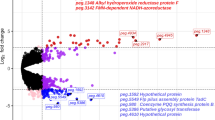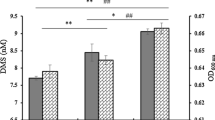Abstract
Desulfitobacterium hafniense Y51 is a dechlorinating bacterium that encodes an unusually large set of O-demethylase paralogs and specialized respiratory systems including specialized electron donors and acceptors. To use this organism in bioremediation of tetrachloroethene (PCE) or trichloroethene (TCE) pollution, expression patterns of its 5,060 genes were determined under different conditions using 60-mer probes in DNA microarrays. PCE, TCE, fumarate, nitrate, and dimethyl sulfoxide (DMSO) respiration all sustain the growth of strain Y51. Global transcriptome analyses were thus performed using various electron donor and acceptor couples (respectively, pyruvate and either fumarate, TCE, nitrate, or DMSO, and vanillate/fumarate). When TCE is used as terminal electron acceptor, resulting in its detoxification, a series of electron carriers comprising a cytochrome bd-type quinol oxidase (DSY4055-4056), a ferredoxin (DSY1451), and four Fe–S proteins (DSY1626, DSY1629, DSY0733, DSY3309) are upregulated, suggesting that the products of these genes are involved in PCE oxidoreduction. Interestingly, the PCE dehalogenase cluster (pceABCT) is constitutively expressed in the media tested, with pceT being upregulated and pceC downregulated in pyruvate/TCE-containing medium. In addition, another dehalogenation enzyme (DSY1155 coding for a putative chlorophenol reductive dehalogenase), is induced 225-fold in that medium, despite not being involved in PCE respiration. Remarkably since the reducing equivalents formed during pyruvate conversion to acetyl-CoA are channeled to electron acceptors including halogenated compounds, pyruvate induces expression of a pyruvate:ferredoxin oxidoreductase. This study paves the way to understanding the physiology of D. hafniense, optimizing this microbe as a bioremediation agent, and designing bioarray sensors to monitor the presence of dechlorinating organisms in the environment.



Similar content being viewed by others
References
Biel S, Simon J, Gross R, Ruiz T, Ruitenberg M, Kröger A (2002) Reconstitution of coupled fumarate respiration in liposomes by incorporating the electron transport enzymes isolated from Wolinella succinogenes. Eur J Biochem 269:1974–1983
Boyer A, Page-Belanger R, Saucier M, Villemur R, Lépine F, Juteau P, Beaudet R (2003) Purification, cloning and sequencing of an enzyme mediating the reductive dechlorination of 2,4,6-trichlorophenol from Desulfitobacterium frappieri PCP-1. Biochem J 373:297–303
Carrillo N, Ceccarelli EA (2003) Open questions in ferredoxin-NADP+ reductase catalytic mechanism. Eur J Biochem 270:1900–1915
Chabrière E, Vernède X, Guigliarelli B, Charon MH, Hatchikian EC, Fontecilla-Camps JC (2001) Crystal structure of the free radical intermediate of pyruvate:ferredoxin oxidoreductase. Science 294:2559–2563
Engelmann T, Kaufmann F, Diekert G (2001) Isolation and characterization of a veratrol:corrinoid protein methyl transferase from Acetobacterium dehalogenans. Arch Microbiol 175:376–383
Furukawa K, Suyama A, Tsuboi Y, Futagami T, Goto M (2005) Biochemical and molecular characterization of a tetrachloroethene dechlorinating Desulfitobacterium sp. strain Y51: a review. J Ind Microbiol Biotechnol 32:534–541
Futagami T, Tsuboi Y, Suyama A, Goto M, Furukawa K (2006) Emergence of two types of nondechlorinating variants in the tetrachloroethene-halorespiring Desulfitobacterium sp. strain Y51. Appl Microbiol Biotechnol 70:720–728
Futagami T, Yamaguchi T, Nakayama S, Goto M, Furukawa K (2006) Effects of chloromethanes on growth of and deletion of the pce gene cluster in dehalorespiring Desulfitobacterium hafniense strain Y51. Appl Environ Microbiol 72:5998–6003
Gerritse J, Drzyzga O, Kloetstra G, Keijmel M, Wiersum LP, Hutson R, Collins MD, Gottschal JC (1999) Influence of different electron donors and acceptors on dehalorespiration of tetrachloroethene by Desulfitobacterium frappieri TCE1. Appl Environ Microbiol 65:5212–5221
Hasona A, Kim Y, Healy FG, Ingram LO, Shanmugam KT (2004) Pyruvate formate lyase and acetate kinase are essential for anaerobic growth of Escherichia coli on xylose. J Bacteriol 186:7593–7600
Hrdy I, Muller M (1995) Primary structure and eubacterial relationships of the pyruvate:ferredoxin oxidoreductase of the amitochondriate eukaryote Trichomonas vaginalis. J Mol Evol 41:388–396
Kaufmann F, Wohlfarth G, Diekert G (1998) O-demethylase from Acetobacterium dehalogenans—cloning, sequencing, and active expression of the gene encoding the corrinoid protein. Eur J Biochem 257:515–521
Lemos RS, Gomes CM, Legall J, Xavier AV, Teixeira M (2002) The quinol:fumarate oxidoreductase from the sulphate reducing bacterium Desulfovibrio gigas: spectroscopic and redox studies. J Bioenerg Biomembr 34:21–30
Loffler FE, Tiedje JM, Sanford RA (1999) Fraction of electrons consumed in electron acceptor reduction and hydrogen thresholds as indicators of halorespiratory physiology. Appl Environ Microbiol 65:4049–4056
Lomans BP, Leijdekkers P, Wesselink JJ, Bakkes P, Pol A, Van Der Drift C, Den Camp HJ (2001) Obligate sulfide-dependent degradation of methoxylated aromatic compounds and formation of methanethiol and dimethyl sulfide by a freshwater sediment isolate, Parasporobacterium paucivorans gen. nov., sp. nov. Appl Environ Microbiol 67:4017–4023
Mackiewicz M, Wiegel J (1998) Comparison of energy and growth yields for Desulfitobacterium dehalogenans during utilization of chlorophenol and various traditional electron acceptors. Appl Environ Microbiol 64:352–355
Magnuson JK, Romine MF, Burris DR, Kingsley MT (2000) Trichloroethene reductive dehalogenase from Dehalococcoides ethenogenes: sequence of tceA and substrate range characterization. Appl Environ Microbiol 66:5141–5147
Maillard J, Schumacher W, Vazquez F, Regeard C, Hagen WR, Holliger C (2003) Characterization of the corrinoid iron-sulfur protein tetrachloroethene reductive dehalogenase of Dehalobacter restrictus. Appl Environ Microbiol 69:4628–4638
Major DW, Mcmaster ML, Cox EE, Edwards EA, Dworatzek SM, Hendrickson ER, Starr MG, Payne JA, Buonamici LW (2002) Field demonstration of successful bioaugmentation to achieve dechlorination of tetrachloroethene to ethene. Environ Sci Technol 36:5106–5116
Maymo-Gatell X, Chien Y, Gossett JM, Zinder SH (1997) Isolation of a bacterium that reductively dechlorinates tetrachloroethene to ethene. Science 276:1568–1571
Mohn WW, Tiedje JM (1990) Catabolic thiosulfate disproportionation and carbon dioxide reduction in strain DCB-1, a reductively dechlorinating anaerobe. J Bacteriol 172:2065–2070
Morita Y, Futagami T, Goto M, Furukawa K (2009) Functional characterization of the trigger factor protein PceT of tetrachloroethene-dechlorinating Desulfitobacterium hafniense Y51. Appl Microbiol Biotechnol 83:775–781
Morris RM, Sowell S, Barofsky D, Zinder S, Richardson R (2006) Transcription and mass-spectroscopic proteomic studies of electron transport oxidoreductases in Dehalococcoides ethenogenes. Environ Microbiol 8:1499–1509
Morris RM, Fung JM, Rahm BG, Zhang S, Freedman DL, Zinder SH, Richardson RE (2007) Comparative proteomics of Dehalococcoides spp. reveals strain-specific peptides associated with activity. Appl Environ Microbiol 73:320–326
Neumann A, Wohlfarth G, Diekert G (1998) Tetrachloroethene dehalogenase from Dehalospirillum multivorans: cloning, sequencing of the encoding genes, and expression of the pceA gene in Escherichia coli. J Bacteriol 180:4140–4145
Neumann A, Engelmann T, Schmitz R, Greiser Y, Orthaus A, Diekert G (2004) Phenyl methyl ethers: novel electron donors for respiratory growth of Desulfitobacterium hafniense and Desulfitobacterium sp. strain PCE-S. Arch Microbiol 181:245–249
Nijenhuis I, Zinder SH (2005) Characterization of hydrogenase and reductive dehalogenase activities of Dehalococcoides ethenogenes strain 195. Appl Environ Microbiol 71:1664–1667
Nonaka H, Keresztes G, Shinoda Y, Ikenaga Y, Abe M, Naito K, Inatomi K, Furukawa K, Inui M, Yukawa H (2006) Complete genome sequence of the dehalorespiring bacterium Desulfitobacterium hafniense Y51 and comparison with Dehalococcoides ethenogenes 195. J Bacteriol 188:2262–2274
Pieulle L, Charon MH, Bianco P, Bonicel J, Petillot Y, Hatchikian EC (1999) Structural and kinetic studies of the pyruvate-ferredoxin oxidoreductase/ferredoxin complex from Desulfovibrio africanus. Eur J Biochem 264:500–508
Pieulle L, Nouailler M, Morelli X, Cavazza C, Gallice P, Blanchet S, Bianco P, Guerlesquin F, Hatchikian EC (2004) Multiple orientations in a physiological complex: the pyruvate-ferredoxin oxidoreductase-ferredoxin system. Biochemistry 43:15480–15493
Pollock JS, Forstermann U, Mitchell JA, Warner TD, Schmidt HH, Nakane M, Murad F (1991) Purification and characterization of particulate endothelium-derived relaxing factor synthase from cultured and native bovine aortic endothelial cells. Proc Natl Acad Sci U S A 88:10480–10484
Prat L, Maillard J, Grimaud R, Holliger C (2011) Physiological adaptation of Desulfitobacterium hafniense strain TCE1 to tetrachloroethene respiration. Appl Environ Microbiol 77:3853–3859
Ragsdale SW (2004) Life with carbon monoxide. Crit Rev Biochem Mol Biol 39:165–195
Rahm BG, Morris RM, Richardson RE (2006) Temporal expression of respiratory genes in an enrichment culture containing Dehalococcoides ethenogenes. Appl Environ Microbiol 72:5486–5491
Schumacher W, Holliger C (1996) The proton/electron ratio of the menaquinone-dependent electron transport from dihydrogen to tetrachloroethene in Dehalobacter restrictus. J Bacteriol 178:2328–2333
Seshadri R, Adrian L, Fouts DE, Eisen JA, Phillippy AM, Methe BA, Ward NL, Nelson WC, Deboy RT, Khouri HM, Kolonay JF, Dodson RJ, Daugherty SC, Brinkac LM, Sullivan SA, Madupu R, Nelson KE, Kang KH, Impraim M, Tran K, Robinson JM, Forberger HA, Fraser CM, Zinder SH, Heidelberg JF (2005) Genome sequence of the PCE-dechlorinating bacterium Dehalococcoides ethenogenes. Science 307:105–108
Smidt H, Song D, Van Der Oost J, De Vos WM (1999) Random transposition by Tn916 in Desulfitobacterium dehalogenans allows for isolation and characterization of halorespiration-deficient mutants. J Bacteriol 181:6882–6888
Smidt H, De Vos WM (2004) Anaerobic microbial dehalogenation. Annu Rev Microbiol 58:43–73
Stevens TO, Tiedje JM (1988) Carbon dioxide fixation and mixotrophic metabolism by strain DCB-1, a dehalogenating anaerobic bacterium. Appl Environ Microbiol 54:2944–2948
Suyama A, Iwakiri R, Kai K, Tokunaga T, Sera N, Furukawa K (2001) Isolation and characterization of Desulfitobacterium sp. strain Y51 capable of efficient dehalogenation of tetrachloroethene and polychloroethanes. Biosci Biotechnol Biochem 65:1474–1481
Suyama A, Yamashita M, Yoshino S, Furukawa K (2002) Molecular characterization of the PceA reductive dehalogenase of Desulfitobacterium sp. strain Y51. J Bacteriol 184:3419–3425
Trieber CA, Rothery RA, Weiner JH (1994) Multiple pathways of electron transfer in dimethyl sulfoxide reductase of Escherichia coli. J Biol Chem 269:7103–7109
Utkin I, Woese C, Wiegel J (1994) Isolation and characterization of Desulfitobacterium dehalogenans gen. nov., sp. nov., an anaerobic bacterium which reductively dechlorinates chlorophenolic compounds. Int J Syst Bacteriol 44:612–619
Vignais PM, Toussaint B (1994) Molecular biology of membrane-bound H2 uptake hydrogenases. Arch Microbiol 161:1–10
Zinder SH, Brock TD (1978) Dimethyl sulfoxide as an electron acceptor for anaerobic growth. Arch Microbiol 116:35–40
Acknowledgments
We thank Dr. C. Omumasaba (RITE) for critical reading of the manuscript. This research was supported by New Energy and Industrial Technology Development (NEDO), Japan.
Author information
Authors and Affiliations
Corresponding author
Rights and permissions
About this article
Cite this article
Peng, X., Yamamoto, S., Vertès, A.A. et al. Global transcriptome analysis of the tetrachloroethene-dechlorinating bacterium Desulfitobacterium hafniense Y51 in the presence of various electron donors and terminal electron acceptors. J Ind Microbiol Biotechnol 39, 255–268 (2012). https://doi.org/10.1007/s10295-011-1023-7
Received:
Accepted:
Published:
Issue Date:
DOI: https://doi.org/10.1007/s10295-011-1023-7




